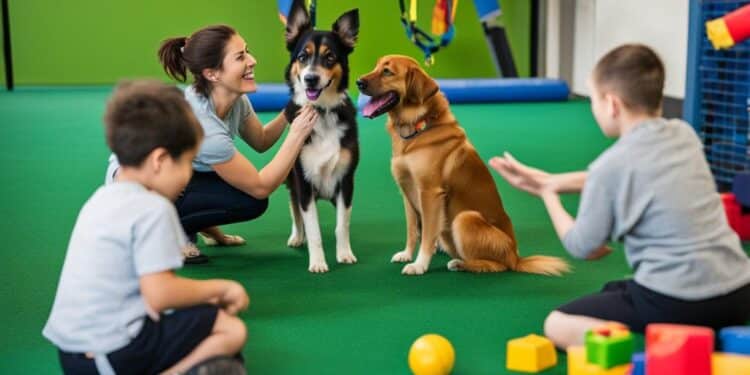Pawsitively Trained: The Power of Positive Reinforcement

Welcome to our comprehensive guide on positive reinforcement training for dogs. In this section, we will explore the effectiveness of reward-based training, clicker training, and the impact of positive feedback in shaping your furry friend’s behavior.
Positive reinforcement training focuses on understanding your dog’s individual needs, tailoring training methods based on their breed, temperament, and history. By teaching basic obedience commands like sit, stay, come, and lie down, you can improve their overall responsiveness.
Utilizing various rewards such as treats and praise, positive reinforcement techniques are incredibly effective in reinforcing good behavior and discouraging unwanted actions. Additionally, we will provide practical solutions for common behavior problems like barking, chewing, and leash pulling.
Socialization and education are key aspects of positive training. We will emphasize the importance of introducing your dog to other animals, people, and environments to ensure a well-rounded and well-behaved companion.
For those looking to take training to the next level, we will explore advanced training techniques like agility training, advanced commands, and mentally stimulating exercises that challenge your dog’s abilities.
If you have a special case, such as a rescue dog, a senior dog, or a dog with behavioral issues, we will guide you on tailoring training methods to meet their unique needs, emphasizing patience and positive reinforcement.
In addition, we will discuss the importance of building a strong bond based on love, trust, and cooperation, and the various training tools and equipment available, such as clickers and harnesses, that can enhance your training experience.
To inspire and motivate you on your training journey, we will share success stories from dog owners who have achieved remarkable results using positive reinforcement methods.
The Difference Between Dog Trainers and Behaviorists
When it comes to training our furry friends, it’s important to understand the difference between dog trainers and behaviorists. While both play a crucial role in helping dogs become well-behaved and happy companions, they approach training from different perspectives.
Dog trainers focus on teaching basic obedience commands and refining a dog’s etiquette. They use positive reinforcement techniques, such as treats and toys, to reward desired behaviors. Trainers are skilled in teaching commands like sit, stay, and come, as well as addressing common behavioral issues like leash pulling or jumping. Their expertise lies in building a strong foundation of obedience and creating a positive bond between the dog and their owner.
On the other hand, behaviorists delve deeper into the canine psyche to address behavioral problems, such as anxiety or aggression. They analyze the dog’s behavior and emotions to determine the underlying causes of these issues. Behaviorists use behavior modification techniques to help the dog overcome their challenges and develop new, positive behaviors. Their approach involves decoding the dog’s body language and providing solutions that help bridge the gap between the dog and their owner.
So, when should you seek a trainer versus a behaviorist? Generally, if you want your dog to learn basic obedience commands and refine their manners, a trainer is the right choice. However, if your dog is dealing with serious behavioral issues, such as aggression or separation anxiety, it’s best to consult with a behaviorist who specializes in behavior modification.
The key takeaway is that both trainers and behaviorists have valuable skills and knowledge that can benefit your furry companion. By understanding the difference between the two and knowing when to seek their expertise, you can ensure your dog receives the appropriate training and behavior support they need.
Table: A Comparison Between Dog Trainers and Behaviorists
| Aspect | Dog Trainers | Behaviorists |
|---|---|---|
| Focus | Basic obedience commands and etiquette | Behavior modification and addressing underlying issues |
| Techniques | Positive reinforcement using treats and toys | Behavior modification techniques |
| Areas of Expertise | Obedience training and addressing common behavioral issues | Diagnosing and treating serious behavioral problems |
| Skills | Teaching commands, refining manners, creating a positive bond | Decoding body language, behavior modification, bridging the gap between dog and owner |
| When to Seek | For basic obedience and manners | For serious behavioral issues like aggression or anxiety |
The Dog Training Community and Harmonizing Approaches
The dog training community is a diverse group of trainers with various techniques and methods. While they may differ in their approaches, there is one universal truth that unites them – the power of positive reinforcement. Regardless of the training method they employ, trainers all agree that rewarding good behavior is key to effective training.
As a dog owner navigating the maze of training methods, it is important to keep a sense of humor and an open mind. Each dog is unique, and what works for one may not work for another. It’s essential to find the right training method that suits your furry friend’s temperament, while still aligning with your own values and beliefs.
Instead of viewing trainers and behaviorists as separate entities, consider harnessing the combined brilliance they offer. By harmonizing the approaches of trainers and behaviorists, you can create a comprehensive training experience for your dog. Trainers can teach basic obedience commands and refine etiquette, while behaviorists can help address deeper behavioral issues and promote emotional well-being.
Ultimately, training your dog should be a joyful and positive experience. Embrace the knowledge and insights shared by the dog training community, and forge a strong bond with your four-legged companion through the power of positive reinforcement.
FAQ
How should I tailor my training methods based on my dog’s breed, temperament, and history?
Understanding your dog’s unique characteristics and background will help you tailor your training methods to their individual needs. Some breeds may require more mental or physical stimulation, while others may have specific behaviors to address based on their genetic tendencies. Assess your dog’s temperament and history to develop a training plan that works best for them.
What are some basic obedience commands I should teach my dog?
Teaching your dog basic obedience commands is essential for their overall responsiveness and safety. Commands like sit, stay, come, and lie down are fundamental building blocks for effective communication with your dog.
How can I use positive reinforcement techniques to train my dog?
Positive reinforcement techniques involve rewarding desired behaviors to reinforce them and discourage unwanted actions. Using treats, praise, and other rewards, you can create a positive association with good behavior and encourage your dog to repeat it.
How can I address common behavior problems like barking, chewing, and leash pulling?
Troubleshooting common behavior problems requires practical solutions. For barking, identifying the trigger and redirecting your dog’s attention can help. To discourage chewing, provide appropriate chew toys and regular exercise to alleviate boredom. Leash pulling can be addressed through leash training exercises and patience.
How important is socialization and education for my dog?
Socialization and education are crucial for a well-rounded and well-behaved dog. It’s important to expose your dog to other animals, people, and various environments to help them become comfortable and confident in different situations.
Are there advanced training techniques I can explore?
If you want to take your dog’s training to the next level, you can explore advanced techniques such as agility training, teaching advanced commands, and engaging in mentally stimulating exercises to challenge your dog’s abilities.
How can I tailor training for special cases like rescue dogs, senior dogs, or dogs with behavioral issues?
Training for special cases requires patience, understanding, and positive reinforcement. Tailor your training methods to accommodate the specific needs of rescue dogs, senior dogs, or dogs with behavioral issues. Emphasize building trust and using positive reinforcement techniques to help them overcome challenges.
What training tools and equipment can enhance my dog’s training?
Various tools like clickers, harnesses, and treats can enhance your dog’s training experience. Clickers can help signal desired behaviors, harnesses can provide better control during walks, and treats can serve as rewards for positive behavior.
Can you share some success stories of dog owners who have successfully trained their dogs using positive reinforcement methods?
Yes! Many dog owners have experienced success with positive reinforcement training, where they have built strong bonds with their dogs and resolved behavioral issues. These inspiring stories show the power of positive reinforcement in fostering well-behaved and happy dogs.
What is the difference between dog trainers and behaviorists?
Dog trainers focus on teaching basic commands and refining a dog’s etiquette using treats and toys as rewards. On the other hand, behaviorists analyze a dog’s psyche, address issues like anxiety and aggression, and concentrate on behavior modification through understanding and addressing underlying causes.
How can trainers help with leash manners, polite greetings, and common behavioral issues?
Trainers can help you teach your dog leash manners, proper greetings, and address common behavioral issues through positive reinforcement techniques. They provide guidance, structure, and support to ensure your dog develops good manners and becomes a well-behaved companion.
What insights can behaviorists provide regarding dog body language and emotions?
Behaviorists can help you decode your dog’s body language and bridge the gap between you and your dog’s emotions. By understanding your dog’s signals, you can better communicate and address their needs, leading to a stronger bond and a happier, more balanced dog.
How can I find the right dog trainer or behaviorist for my dog?
When seeking a trainer or behaviorist, check their credentials and reviews to ensure they are qualified and experienced. Look for someone who aligns with your training philosophy and has positive feedback from other dog owners.
When should I seek a behaviorist instead of a trainer?
If your dog is experiencing serious problems like aggression or separation anxiety, it may be necessary to call in a behaviorist. Behaviorists specialize in understanding and modifying complex behavioral issues and can provide tailored solutions for your dog’s specific needs.
How can behaviorists help me understand my dog’s language and improve communication?
Behaviorists can help you interpret your dog’s barks, wiggles, and ear twitches, allowing you to understand and respond to their communication effectively. By working with a behaviorist, you can develop a deeper level of understanding and connection with your dog.
How can enrolling in a behaviorist’s program benefit me and my dog?
Enrolling in a behaviorist’s program can provide you with the knowledge and skills to communicate effectively with your dog. The program will guide you in understanding and addressing your dog’s behavioral issues and help you create a harmonious and happy relationship with your furry companion.
What is the dog training community like, and how can different training methods be harmonized?
The dog training community is a diverse group of trainers with different techniques and methods. While trainers may have varied approaches, they all agree on the power of positive reinforcement. Harmonizing different approaches involves blending the skills and knowledge from both trainers and behaviorists to create a well-rounded training experience for your dog.
How should I navigate the different training methods and choose the right one for my dog?
Navigating the maze of training methods may seem overwhelming, but keeping a sense of humor and an open mind is crucial. Consider your dog’s individual needs, temperament, and your training goals when choosing a method. Remember, the ultimate goal is to create a positive and enjoyable training experience for both you and your furry companion.
How can trainers and behaviorists work together for a successful partnership?
Trainers and behaviorists can harmonize their skills and work together to provide a comprehensive training experience for your dog. By combining the technical expertise of trainers and the psychological insights of behaviorists, you can create a training plan that addresses both the physical and emotional needs of your dog.
What mindset should I have while training my dog?
Keeping a positive mindset and enjoying the journey of training your furry companion is key. Training should be a fun and rewarding experience for both you and your dog. Remember to celebrate small victories and embrace the bond you are building with your furry friend.






